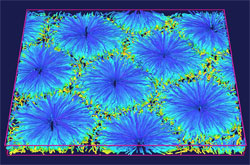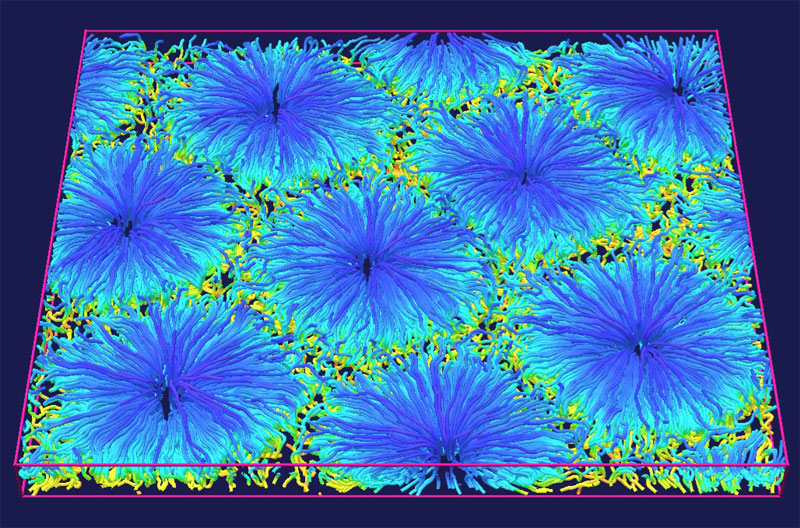Cooking up a Smart Nanofluid
Specialized nanoparticles floating in water make a fluid that can be switched between two states with different thermal properties, according to the 13 March Physical Review Letters. If the particles start out evenly distributed throughout the fluid volume, heat transfers more rapidly through the fluid than if they are more concentrated close to the heat source. The flow pattern is not fixed like the steady rolling produced in pure water, which suggests more complicated physics than researchers had previously predicted. But the team hopes some version of their fluid can be used to improve the regulation of heat flow in future devices.
Fluids transport heat through conduction and convection. Conduction transfers heat through the motion of molecules bumping into their neighbors and doesn’t require any large-scale motion of the fluid. In convection, when a fluid is heated from below, the lower layers warm and become less dense, then rise to the surface, displacing the cooler and denser fluid above and creating a vertically circulating flow. Convection governs many ocean and atmospheric currents, and it can transport much more heat than conduction.
Researchers can completely shut down convection by adding “thermophilic” nanoparticles to a fluid. These particles are attracted to warmer regions for reasons that aren’t entirely clear, and when the “nanofluid” is heated from below, the particles move toward the heat source and prevent the warm lower layer from floating upward. If more heat is applied, more particles move down and oppose it. But based on recent theoretical data, Alberto Vailati and his colleagues at the University of Milan suspected that such a nanofluid could support convection when heated, as long as the nanoparticles started out evenly distributed in the vertical direction.
They sandwiched a 4 percent solution of nanoparticles made of a Teflon-like plastic in water between two transparent, sapphire plates, above and below a 3-millimeter-thick, disk-shaped cell. To create an even distribution of the nanoparticles, the researchers heated the top plate relative to the bottom, choosing a small temperature difference (3 degrees Kelvin) that exactly counterbalanced the particles’ slight tendency to sink due to gravity. After keeping the cell in this condition for about three days, the team abruptly heated the sample from below and monitored the fluid flow from above using “shadowgraph” images, which show levels of gray that primarily represent variations in density.
Initially, the nanofluid developed a stable convective pattern, similar to plain water. However, after a few minutes, the convective flow acquired horizontal rolls, ripples, and waves. This “oscillatory” convection continued indefinitely if the temperature difference was large enough, and the team found similar patterns when they used silica nanoparticles. Theoretical models, by contrast, had predicted that a nanofluid would act like plain water and maintain a fixed convection pattern. The team suspects that the theories don’t fully account for the complex interactions between the settling nanoparticles and the mixing caused by convection, but they hope theorists can use their new data to improve the models.
Vailati and his colleagues showed that the fluid transported more heat from the bottom plate to the top plate in the convecting state than in the static, conducting state that resulted when the particles were initially allowed to sink toward the heat source. Vailati sees practical uses for a fluid with two different possible rates of heat transfer. Most standard heat transfer systems try to dissipate as much heat as possible, he says, but heat transfer with a “smart” fluid–assuming many more refinements beyond this proof-of-concept–could provide controlled heating or cooling as needed.
To make the leap to heating and cooling technologies, the researchers will need to show more evidence of a stable running system that responds to a wider range of heat inputs, says Dieter Braun, of the Ludwig Maximilian University in Munich. However, the findings add a new twist to well-established physics, he says. “It’s always nice if you have a system which has a lot of history and you can add fundamentally new ideas to it.”
–Sarah Webb
Sarah Webb is a freelance science writer in Brooklyn, New York.





